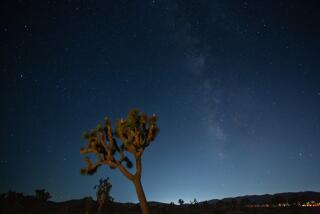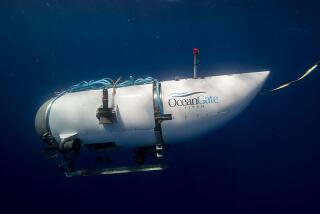African Safaris Challenge the Ability to Prepare
- Share via
Almost everyone likes to take photographs of animals, but after awhile they do start to look the same. After all, how many pictures can you get of a bear waving as the tour bus goes by?
If this is the case, you may be ready for the next plateau--an African safari.
The price--$2,500 to $4,000--may be an obstacle for most, but the adventure behind it is certainly appealing.
Those who decide to take an African safari should know that shooting Kodachrome slides of elephants and lions in their natural habitats can’t be done well without proper advance planning and research.
“Most people think that going to Africa is like going to the San Diego Zoo,” said Bob Greenburg, a nature photographer and Newport Beach obstetrician-gynecologist who is planning his fifth trip to Africa.
“It is totally a misconception because wild animals are unique. They are alert, alive, they have personality, they look at you and they interact with you. Animals that are in a zoo, like any captive creature, have their spirit broken and are nervous and circle their cages.
“African animals in the wild have to be alert because if they’re not, they’re lunch.”
Here are a few of Greenburg’s recommendations for a successful safari:
Selecting a tour--The best tour operator is one who comes recommended by a friend or someone that has been on a recent safari. Don’t be misled by brochures making grandiose claims. Some of the better operators may be a little more expensive, but the extra money will probably greatly increase your comfort.
You should find out how many people will be in each van. The tour companies usually have mini-vans that seat nine people, which, with luggage, can be a tight fit. The maximum should be four or five.
Professional photographers leading the tour--If there is a professional photographer leading the trip, check his or her references. You will be paying for his trip to Africa, so he can take photographs to fill his stock files. Be sure the references are from a recent trip. Ask if the photographer caters to both beginning and advanced shooters. The photographer should help you with your pictures so when you come home the results are worthy of your investment in the trip.
Equipment--For the average traveler, Greenburg recommends a wide-angle lens, 28- or 35-millimeter up to a telephoto lens of 300-mm. at the minimum. For animal photography, a 400-mm. lens is best.
A bean bag or a Steady Bag is a great way of steadying the camera and lens on the van. Trying to use a tripod while shooting through the roof of the van becomes awkward.
Those who don’t wish to carry a Steady Bag should take an empty bean bag with them and at the first market fill it with dried rice, beans or peas and use it as a camera support. After the safari give the rice or beans to your driver. Food is very expensive and will be appreciated.
Always take an extra camera body along. The African dust can ruin the moving parts of your camera.
Film--Double the amount of film you originally plan to take. Greenburg shoots mostly Kodak’s Kodachrome 64-slide film. He also shoots a lesser amount of Kodachrome 200 for low-light situations. He takes the film out of the box, puts it into a sealed plastic bag and has it hand-examined at the airports, making sure it is not put through X-rays.
It’s important to pace yourself. A rule of thumb is four rolls of 36 exposures a day when shooting in the national parks. Greenburg says he has shot up to 25 rolls in one day at a lodge where a herd of elephants was approaching the water hole.
Accommodations--Tour operators offer accommodations ranging from very nice lodges at the national parks with all the comforts to tents.
Mosquitoes--They are probably the only insects you’ll have to worry about. Most of the camps and lodges at night provide mosquito protection and spray the rooms at sundown.
Medicine--Greenburg recommends taking protective products for the eyes and lips. You may also need medication for sore throats, sunburn and scrapes.
Reservations--Reservations should be made at least six months in advance.
Mornings--You usually wake up at 5:30 a.m. and have coffee at 6 a.m. You then drive to the game preserves until 8:30 a.m., stopping when you see animals.
The Safari--In game parks it’s a law that you have to stay in the vans. Animals view you as no threat when you’re in a van. The drivers are specially trained for these situations. Some of the game lodges offer bunkers or verandas from which to shoot. They can give you a different perspective.
Shooting Photographs--The experience of shooting pictures is phenomenal. It’s an unbelievable feeling when you look through your camera at a lion roaring in your face. Using a fast shutter speed such as 1/250 or faster can greatly improve your nature shots. Also try to shoot a highlight in the animal’s eye, which can make a photograph come to life. Without this, the animal might as well be stuffed in a museum.
Also drape a focusing cloth over your head and the camera to enhance your ability to focus accurately in the bright sunlight.
Don’t overextend yourself, because fatigue can make you rush your photographs and cause you to get careless with focus and composition. Select a tour with fewer parks so you’ll be able to get more detail at each stop. Remember, patience is a virtue while on safari.
Natives--Try to establish a rapport with people you want to photograph. Introduce yourself and ask their names. Don’t just stick a camera in their face and start snapping. Many times the natives will ask to have a photograph sent back to them. Rarely do people ever keep their promise. So, Greenburg takes along a Polaroid camera and just gives them that picture.
Music--Most of the gift shops at the lodges sell recorded music of the local tribes. Consider buying a cassette for background music for your slide show when you return.
Recommendations--Greenburg’s favorite park is Mountain Lodge at Mount Kenya National Park in Kenya. It’s an opportunity to be in a beautiful rustic building overlooking a water hole and salt lick.
It has an underground viewing bunker or you can shoot from the balcony of your room or the roof of the hotel. It also has some rarely seen animals such as bush pigs and giant forest hogs in addition to elephants, cape buffalo, antelope and gazelles.
Another favorite is the Mara Serena Lodge at Masai Mara National Park in Kenya. It was built as a replica of a Masai tribe’s village, but with all the amenities of a resort.
More to Read
Sign up for The Wild
We’ll help you find the best places to hike, bike and run, as well as the perfect silent spots for meditation and yoga.
You may occasionally receive promotional content from the Los Angeles Times.







